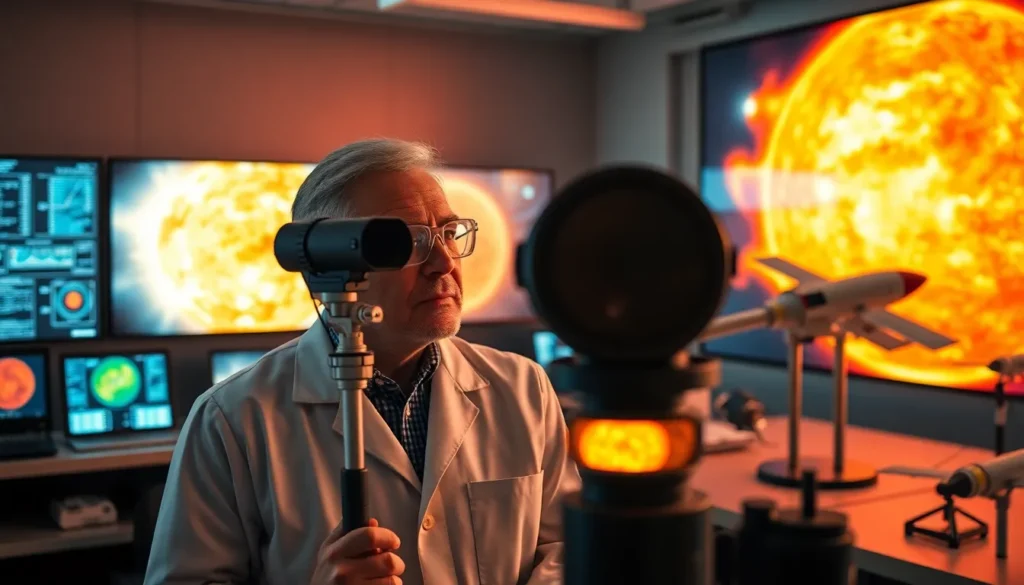Table of Contents
ToggleAs humanity gazes up at the vastness of the cosmos, solar exploration emerges as a frontier filled with promise and intrigue. With advancements in technology and a growing understanding of our solar system, scientists are eager to unlock the mysteries of the Sun and its celestial neighbors. This journey not only enhances knowledge about our own planet but also paves the way for future exploration beyond Earth.
From studying solar flares to examining the atmospheres of distant planets, solar exploration fuels curiosity and innovation. It holds the potential to reveal insights that could transform our understanding of space and its impact on life. As missions to the Sun and its planetary companions continue to evolve, the quest for knowledge becomes more thrilling than ever.
Overview of Solar Exploration
Solar exploration encompasses the study of the Sun and its influence on the solar system. Scientists utilize various missions and instruments to capture data on solar phenomena, such as solar flares and coronal mass ejections. These events play a pivotal role in understanding space weather and its impact on Earth.
Technological advancements, including satellites and space probes, enhance the ability to monitor solar activity in real time. For example, NASA’s Solar Dynamics Observatory (SDO) provides detailed images of the Sun’s surface, allowing researchers to analyze solar activity’s patterns and effects on Earth’s atmosphere.
Research into the atmospheres of exoplanets also benefits from solar exploration. By studying light from distant stars, scientists can infer atmospheric composition and conditions on these planets. Observatories like the Kepler Space Telescope contribute valuable information, expanding knowledge about the potential for life elsewhere in the universe.
Current missions, such as the Parker Solar Probe, aim to journey closer to the Sun than ever before. These missions focus on uncovering the mechanisms behind solar winds and magnetic fields, further illuminating the Sun’s dynamics. The pursuit of knowledge in solar exploration continues to inspire curiosity and drive scientific discovery.
Key Missions in Solar Exploration

Various missions contribute significantly to solar exploration, enhancing understanding of solar phenomena and their effects on the solar system. Key missions such as SOHO and the Parker Solar Probe exemplify the push for deeper insights into solar dynamics.
Solar and Heliospheric Observatory (SOHO)
SOHO, launched in 1995, serves as a crucial instrument in solar study. SOHO monitors the Sun continuously, providing real-time data on solar flares, coronal mass ejections, and solar wind. SOHO’s imaging instruments, like the Extreme Ultraviolet Imaging Telescope, deliver high-resolution images of the solar atmosphere. This mission plays a vital role in space weather forecasting by analyzing solar activity and its potential impacts on Earth.
Parker Solar Probe
The Parker Solar Probe, initiated in 2018, stands out as the first spacecraft to fly into the Sun’s corona. This mission aims to gather data on solar winds and the Sun’s magnetic fields up close. The probe utilizes cutting-edge heat-resistant materials to withstand intense heat, approaching within 3.83 million miles of the Sun’s surface. By studying the mechanisms behind solar phenomena, the Parker Solar Probe contributes essential knowledge that enhances understanding of solar behavior and its influence on solar system interactions.
Scientific Discoveries from Solar Exploration
Solar exploration has led to numerous scientific discoveries that expand understanding of solar phenomena and their impacts across the solar system. By analyzing solar flares, coronal mass ejections, and solar winds, researchers gain insights into the Sun’s behavior and its influence on Earth and beyond.
Solar Flares and Coronal Mass Ejections
Solar flares are sudden bursts of energy and radiation from the Sun’s surface. These events can release immense amounts of energy, sometimes equivalent to millions of hydrogen bombs. Data from missions like the Solar and Heliospheric Observatory (SOHO) allow scientists to monitor solar flares in real-time, providing critical information for space weather forecasting. Coronal mass ejections (CMEs) involve large quantities of plasma and magnetic fields being expelled from the Sun’s corona. Understanding these phenomena helps researchers predict space weather impacts, such as geomagnetic storms that can disrupt satellites and power grids on Earth.
Solar Wind and Its Effects
Solar wind comprises charged particles constantly released from the Sun. It travels throughout the solar system, influencing planetary atmospheres and magnetic fields. Instruments aboard the Parker Solar Probe collect data on solar wind characteristics, revealing its speed, density, and composition. This information aids in understanding how solar wind interacts with planetary bodies, including Earth. The impact of solar wind on technology, such as navigation systems and communication networks, emphasizes the necessity of monitoring solar activity closely to mitigate potential disruptions.
Technology Used in Solar Exploration
Solar exploration relies on advanced technology to gather data and improve understanding of solar phenomena. Various instruments and satellites play crucial roles in monitoring the Sun and its effects on the solar system.
Instruments and Satellites
Instruments and satellites utilized in solar exploration include several key technologies that enhance observational capabilities.
- Solar Dynamics Observatory (SDO): Launched in 2010, SDO continuously captures high-resolution images of the Sun, focusing on solar flares and the Sun’s magnetic field.
- Solar and Heliospheric Observatory (SOHO): Since 1995, SOHO has provided real-time monitoring of solar activity, including white-light images to track coronal mass ejections.
- Parker Solar Probe: Initiated in 2018, this mission enables the study of the solar corona by flying closer to the Sun than any previous spacecraft, collecting data on solar winds and magnetic fields.
- Helios Probes: Launched in the 1970s, these probes helped gather crucial data on solar wind and magnetic fields in the inner solar system.
- Interplanetary Parker Solar Probe: Functioning as a groundbreaking component of solar research, this probe withstands extreme temperatures, facilitating detailed studies of solar dynamics.
These instruments and satellites equip scientists with the necessary data to analyze solar activity and its implications for the solar system.
Future Technologies in Solar Research
Future technologies promise to enhance solar exploration capabilities significantly.
- Advanced Solar Telescopes: Innovations in solar telescope technology aim to provide higher resolution images and greater detail of solar phenomena.
- Space-Based Sensor Arrays: Deployment of sensor arrays in solar orbits could allow for continuous monitoring of solar activity in real-time.
- Artificial Intelligence (AI): AI techniques may process vast amounts of data collected from various missions, improving detection and prediction of solar events.
- Quantum Sensors: The development of quantum sensors holds potential for measuring subtle changes in solar radiation and magnetic fields.
- Increased Swarm Missions: Future missions could deploy multiple satellites in formations to enhance data collection capability and spatial understanding of the solar environment.
These emerging technologies aim to expand knowledge of solar processes and their broader impacts on the solar system, setting the stage for groundbreaking discoveries in solar physics.
Challenges in Solar Exploration
Solar exploration faces several significant challenges that impact research and data collection.
- Extreme Environment: The Sun’s intense heat and radiation create an extreme environment for spacecraft. Instruments must withstand temperatures exceeding 2,500 degrees Fahrenheit while remaining operational.
- Distance from Earth: The vast distance between Earth and the Sun complicates communication and data transmission. Signal delays can impact real-time analysis and immediate response to solar events.
- Data Overload: The volume of data generated by solar missions is immense. Processing and analyzing this data requires advanced algorithms and significant computational resources, presenting logistical and technical hurdles.
- Space Weather Prediction: Accurately forecasting space weather relies on understanding complex solar phenomena. Variability in solar activity complicates modeling efforts, affecting reliability in predicting geomagnetic storms that impact Earth.
- Funding and Resource Limitations: Research in solar exploration often depends on government funding and institutional resources. Budget constraints can limit mission scope and technological advancements, impeding progress in this dynamic field.
- Interdisciplinary Collaboration: Successful solar exploration necessitates collaboration among various scientific disciplines. Coordinating efforts across fields, such as physics, engineering, and atmospheric science, can face institutional barriers.
- Long-Term Missions: Many solar missions require extensive timelines to gather comprehensive data. Long-term planning and commitment challenge scientific teams, particularly as new technologies emerge and priorities shift.
These challenges highlight the complexities involved in solar exploration while emphasizing the critical role of continued investment and innovation in overcoming obstacles.
Solar exploration stands at the forefront of scientific discovery. As missions like the Parker Solar Probe and SOHO continue to gather invaluable data, the potential for groundbreaking insights into the Sun and its influence on the solar system grows. The challenges faced in this field highlight the need for innovative solutions and interdisciplinary collaboration. With advancements in technology and a commitment to understanding solar phenomena, researchers are poised to unlock new knowledge that could reshape our understanding of space and its effects on life on Earth. The journey into the depths of solar exploration promises to be as enlightening as it is thrilling.







